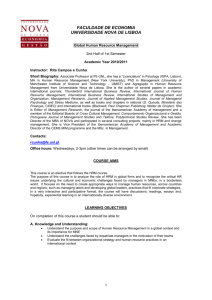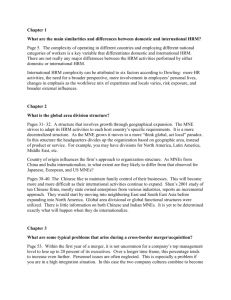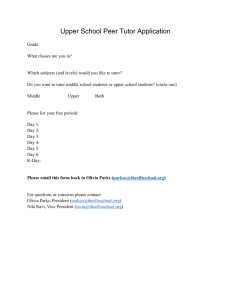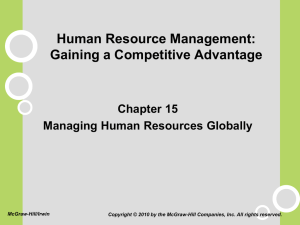MN5421 Managing People in Global Markets
advertisement
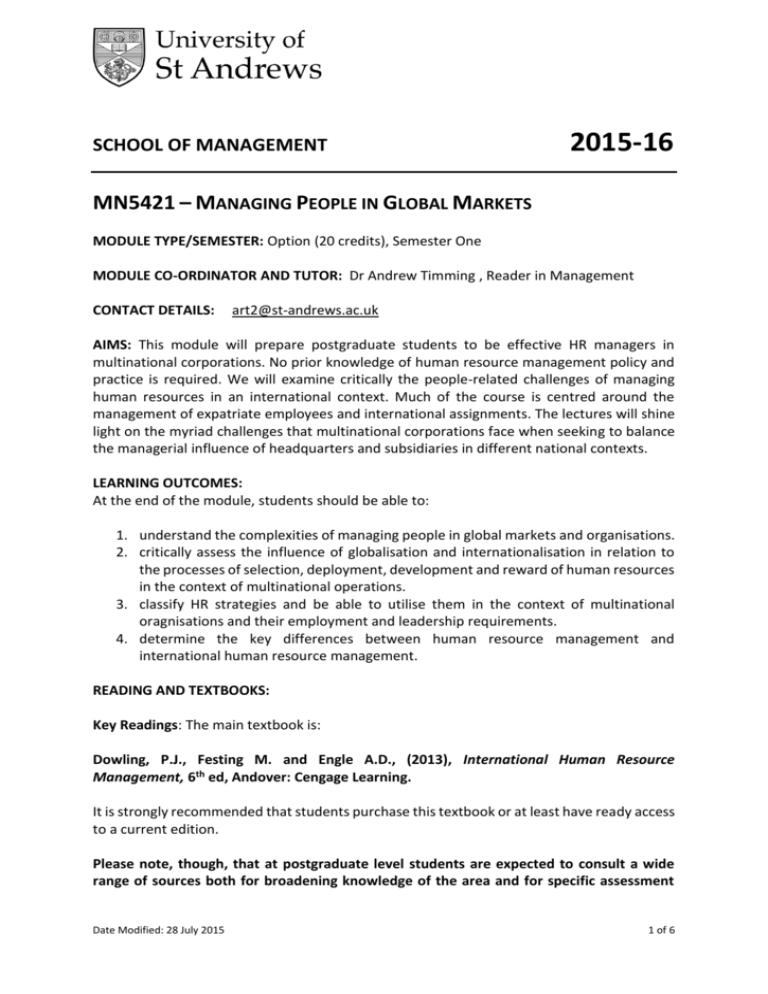
SCHOOL OF MANAGEMENT 2015-16 MN5421 – MANAGING PEOPLE IN GLOBAL MARKETS MODULE TYPE/SEMESTER: Option (20 credits), Semester One MODULE CO-ORDINATOR AND TUTOR: Dr Andrew Timming , Reader in Management CONTACT DETAILS: art2@st-andrews.ac.uk AIMS: This module will prepare postgraduate students to be effective HR managers in multinational corporations. No prior knowledge of human resource management policy and practice is required. We will examine critically the people-related challenges of managing human resources in an international context. Much of the course is centred around the management of expatriate employees and international assignments. The lectures will shine light on the myriad challenges that multinational corporations face when seeking to balance the managerial influence of headquarters and subsidiaries in different national contexts. LEARNING OUTCOMES: At the end of the module, students should be able to: 1. understand the complexities of managing people in global markets and organisations. 2. critically assess the influence of globalisation and internationalisation in relation to the processes of selection, deployment, development and reward of human resources in the context of multinational operations. 3. classify HR strategies and be able to utilise them in the context of multinational oragnisations and their employment and leadership requirements. 4. determine the key differences between human resource management and international human resource management. READING AND TEXTBOOKS: Key Readings: The main textbook is: Dowling, P.J., Festing M. and Engle A.D., (2013), International Human Resource Management, 6th ed, Andover: Cengage Learning. It is strongly recommended that students purchase this textbook or at least have ready access to a current edition. Please note, though, that at postgraduate level students are expected to consult a wide range of sources both for broadening knowledge of the area and for specific assessment Date Modified: 28 July 2015 1 of 6 exercises. Other books which provide detailed and analytical perspectives on strategic and international HRM and related topics include: Atzeni, M. (ed) (2014) Workers and Labour in a Globalised Capitalism. Palgrave. A series of critical readings focusing on the position of workers in societies affected by increasing globalization. Boxall P. & Purcell J., (2008) Strategy & Human Resource Management, 2nd edn, Palgrave. This text adopts a critical approach. Branine, M. (2011) Managing Across Cultures, Sage. This comprehensive text reviews international HRM issues from a worldwide/country perspective. Bratton, J. & Gold, J. (2012) Human Resource Management: Theory & Practice, 5th edn. Palgrave. A good text on the general aspects of HRM with a useful chapter on international HRM. Crawley, E., Swailes, S. and Walsh, D. (2013) Introduction to International Human Resource Management. Oxford University Press. A good text covering all the key areas and a useful chapter on the very contemporary issue of migrant labour. Also has a good set of web-based support materials. Harzing, A-W. & Pinnington, A.H. (2011), International Human Resource Management (3rd ed). Sage. A lot like the required text, but longer and more in-depth. Legge K. (2005), Human Resource Management: Rhetorics and Realities, Palgrave. A now classic and critically acclaimed text. Lucio, M. (ed) (2014) International Human Resource Management: An Employment Relations Perspective. Sage. Set within a comprehensive theoretical and practical context this text comprises a series of critical chapters covering many aspects of the internal and external features of the subject. Good companion website for students. Students should also get into the habit of regularly consulting leading appropriate journals available in the library. These include, but are not limited to: British Journal of Industrial Relations (BJIR) Work, Employment & Society (WES) Industrial Relations Journal (IRJ) European Journal of Industrial Relations (EJIR) Economic and Industrial Democracy (EID) International Journal of Human Resource Management (IJHRM) Human Resource Management Journal (HRMJ) Human Relations (HR) Human Resource Management Review (HRMR) Harvard Business Review (HBR) Business Strategy Review (BSR) Date Modified: 28 July 2015 2 of 6 Strategic Management Journal (SMJ) Sloan Management Review (SMR) Journal of Management Studies (JMS) Organization Studies (OS) Of these, the International Journal of Human Resource Management is possibly the most useful. It offers highly appropriate articles based on current research. SOME USEFUL WEBSITES http://www.cipd.co.uk/ The CIPD, the Chartered Institute of Personnel and Development, is a major professional association for those working and teaching in all aspects of HRM/HRD. Although UK-based and with most of its members in employment in the UK, it has a growing membership around the world. Look at the links on the CIPD’s website to various aspects of HRM and global trends in the subject. http://www.ilo.org/global/lang--en/index.htm#a2 The ILO, the International Labour Organisation, is a specialized agency of the United Nations that works with employers, government and workers around the world to promote internationally recognized standards of employment practice. http://www.oecd.org/home/0,2987,en_2649_201185_1_1_1_1_1,00.html The OECD, the Organisation for Economic Co-operation and Development, aims to promote policies that will improve the economic and social well-being of people around the world. Also, please note a number of readings will be provided through the course and will be made available on Moodle. TEACHING PROGRAMME Week 1: Introduction to International HRM Tutor: Dr Andrew R Timming Following a general welcome and introductions, this first session for the module provides an outline of the course and the general area of study known as International Human Resource Management (IHRM). Week 2: Expatriate Staffing Tutor: Dr Andrew R Timming This lecture will give a general overview of how to recruit and select expatriate managers effectively in multinational corporations. It will pay particularly close attention to ‘best practices’ in staffing expatriates and on how to identify the best characteristics of an effective expatriate employee. Date Modified: 28 July 2015 3 of 6 Week 3: Expatriate Performance Appraisal Tutor: Dr Andrew R Timming This lecture will outline the steps for carrying out an effective performance appraisal of international expatriates. The key differences between international and conventional expatriate performance management will be articulated. Week 4: Expatriate Training and Development Tutor: Dr Andrew R Timming This lecture will outline ‘best practices’ for assessing and meeting the training and development needs of international expatriates. In particular, we will focus on how to create cross-cultural as well as technical competence to ensure the success of an international assignment. Week 5: Expatriate Compensation Management This lecture examines best practices in international compensation and benefits management. It will look at how HR managers in multinational corporations can create a reward package that motivates expatriates to achieve their goals. Week 6: READING WEEK NO CLASS Week 7: Guest Lecture Tutor: Dr Andrew R Timming This lecture will feature a guest contribution. Details will be announced in due course. Week 8: Strategic IHRM and the Transfer of Best Practice Tutor: Dr Andrew R Timming This lecture will look at the nature of strategic IHRM, the various forces of isomorphism, the concept of benchmarking of best practices as well as the strategy of coercive comparisons. Week 9: Comparative Industrial Relations Tutor: Dr Andrew R Timming This lecture will look at comparative industrial relations, especially in the context of Europe. We will follow a case study and demonstrate why it is important for managers to be aware of different industrial relations systems. Week 10: Student Presentations Tutor: Dr Andrew R Timming This week students will make a group presentation. Date Modified: 28 July 2015 4 of 6 Week 11: Revision Session Tutor: Dr Andrew R Timming There will be no lecture this week. Students can attend this revision session in order to ask questions and prepare for the final examination. ASSESSMENT 1. Individual essay, maximum 2000 words (excluding references). Assessment Weight = 25%. 2. One group-based report, max. 3000 words (no references to be included in this report). Assessment Weight = 20%. 3. Group presentation, 15 minutes per group. Assessment Weight = 5% 4. Unseen examination, TWO hours. Assessment Weight = 50% INDIVIDUAL ESSAY: To be submitted on [date to be arranged]. One hardcopy to be submitted to the Postgraduate Office on Level 3 of the Gateway and one copy to be submitted electronically via the Module Management System (MMS). Individual essay, maximum 2000 words (+/- 10%), excluding references and appendices. Topic: Critically compare and contrast human resource management practices in the United Kingdom and one other country. GROUP ASSIGNMENT: To be submitted on [date to be arranged]. One hardcopy to be submitted to the Postgraduate Office on Level 3 of the Gateway and one copy to be submitted electronically via the Module Management System (MMS). Step1: Choose a work team of 5 or 6 people. We will start this process on the first meeting. Six people are a maximum. Four people are a minimum. Step2: Pick any (real) British-based company that does not have any international presence. Do some background research about the company to understand its market situation and current challenges, especially in relation to the HR function. Now pick and justify any international market to which you plan to expand (either greenfield or brownfield). Step 3: Write a report for your CEO. In it, you need to justify the need for an international expansion and articulate a clear plan, consisting of best practices, for establishing an effective HR function in the new country. Date Modified: 28 July 2015 5 of 6 The submission is to be presented in the form of a polished company report, so no academic references are to be included. Presentation and aesthetics will count. Length of the written submission: 2000 words (+/- 10%). Potential Sources: Internet search Interviews with people known in the industry Company databases Company reports Financial and business press, such as Financial Times, The Economist, Fortune, Business Week, etc. But keep the use of popular sources to a minimum! Industry and Trade Journals (People Management) Specialist industry or sector books GROUP PRESENTATION: You and your team are expected to give a 15-minute presentation in Week 10. Imagine you are presenting to the CEO and board of directors of your company. Your job is to convince them that you have an effective plan in place for managing human resources in the new market. EXAMINATION: Further information and guidance to be provided in due course. Date Modified: 28 July 2015 6 of 6

